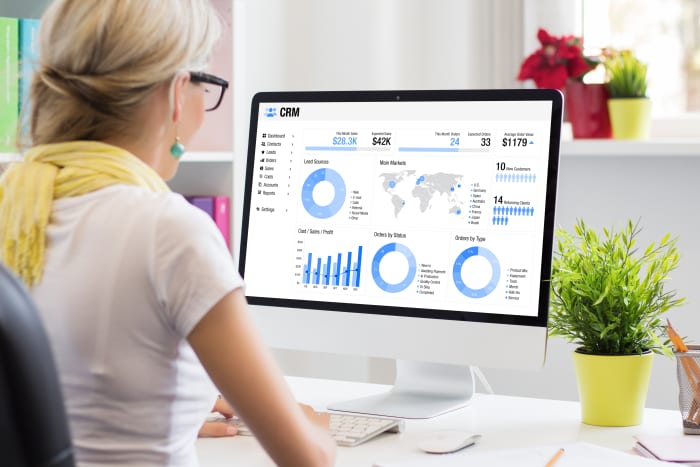9 Steps and Tips to Create a Healthcare CRM System


The healthcare industry is one of those fields where the implementation of advanced technologies allows it to evolve drastically.
And one of the most significant developments is adopting customer relationship management (CRM) systems. Healthcare CRM systems give healthcare providers a powerful tool for managing patient relationships, tracking patient data, and improving patient outcomes.
However, developing a healthcare CRM system can be challenging and complex, requiring a deep understanding of the healthcare industry and its unique requirements. This article will provide a comprehensive guide to healthcare CRM development, covering everything from planning and design to implementation and maintenance.
If you’re a healthcare provider looking to improve patient care who wants to know how to develop a healthcare CRM solution, this guide will provide you with the knowledge and resources you need to create a successful healthcare CRM solution.
Without further ado, let's explore the world of healthcare CRM development.
What is CRM software for healthcare?
A healthcare CRM system is a software tool allowing healthcare providers to manage patient relationships more effectively.
It provides a centralised database where healthcare providers can store patient information, track patient interactions, and communicate with them more efficiently.
A healthcare CRM system is designed to meet the specific needs of the healthcare industry. It allows healthcare providers to manage patient data, track appointments, monitor patient health, and provide personalised care.
Healthcare CRMs are also helpful for managing relationships with other stakeholders in the healthcare ecosystem, such as insurance companies, referring physicians, and other healthcare providers.
EHR and CRM — what's the difference?
Some people may confuse CRMs and EHRs (electronic health records). But these systems serve different purposes in the healthcare industry.
An EHR is a digital system that stores and manages a patient’s health information, including medical history, medications, allergies, and laboratory test results.
Additionally, EHRs are used by healthcare providers to document patient care, communicate with other healthcare providers, and improve patient outcomes. EHRs, typically used within a single healthcare organisation such as a hospital or clinic, are primarily focused on clinical workflows.
A healthcare CRM is a system designed to manage relationships with patients and potential patients. Healthcare CRMs can track patient interactions and manage communication, scheduling, and follow-up. Healthcare organisations typically use healthcare CRMs to drive patient engagement, marketing, and outreach efforts.
In summary, an EHR is a system for managing clinical information, while a CRM is a system for managing patient relationships and engagement. While there can be some overlap between the two systems, they serve different purposes and are used by various healthcare professionals within an organisation.
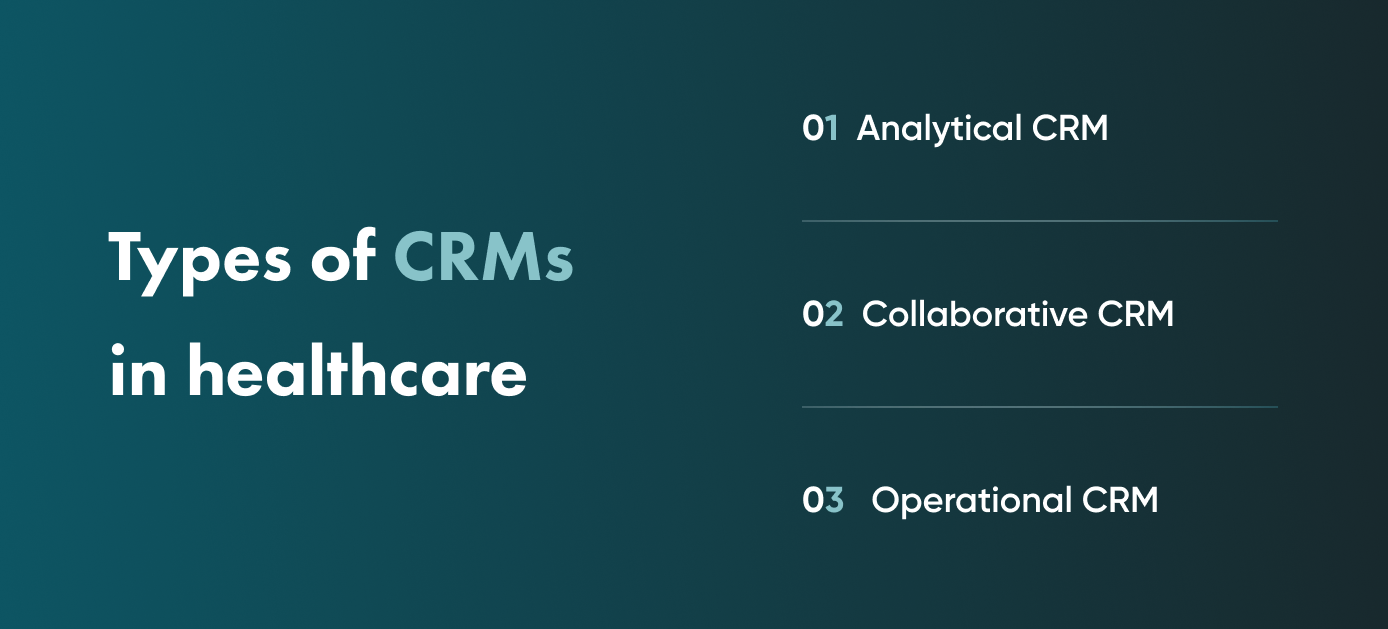
Types of CRMs in healthcare
Healthcare CRMs may have a few types, and they can be analytical, collaborative, or operational. Here's a breakdown of each type:
Analytical CRM
Analytical CRM software analyses data to gain insights into patient behaviour, preferences, and trends. It allows healthcare organisations to understand patient needs, identify growth opportunities, and make informed decisions.
Some examples of analytical CRM software in healthcare include Salesforce Health Cloud Analytics and IBM Watson Health.
Collaborative CRM
Collaborative CRM software facilitates communication and collaboration among healthcare providers, patients, and other stakeholders.
It enables healthcare organisations to improve care coordination, enhance patient engagement, and streamline workflows. Examples of collaborative CRM software in healthcare include Salesforce Health Cloud and HubSpot Health CRM.
Operational CRM
Operational CRM software automates and optimises core business processes within healthcare organisations. It includes features such as patient management, appointment scheduling, and billing.
As a result, operational CRM software helps healthcare providers improve efficiency, reduce costs, and enhance patient satisfaction. Some examples of operational CRM software in healthcare include Pipedrive Health, SugarCRM, and Insightly.
By understanding the functionalities of different types of medical CRM, healthcare organisations can select the best solution for their specific needs and improve patient outcomes.
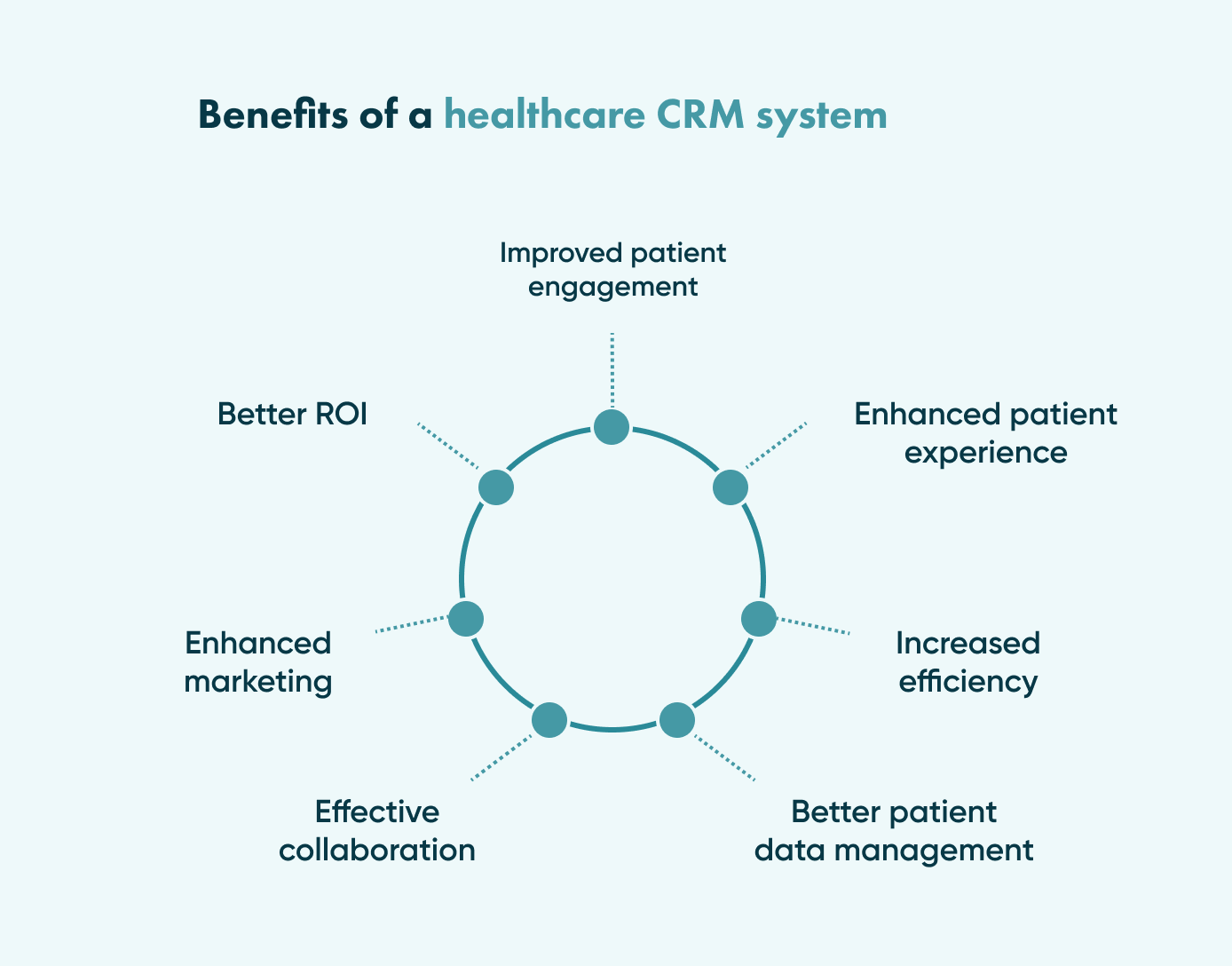
Advantages of healthcare CRM software
Why do you need to build CRM software for healthcare? See the specific reasons to do it below.
Improved patient engagement
Healthcare CRM software helps healthcare providers manage patient interactions and communication throughout the patient journey.
By providing personalised and timely communication, such as appointment reminders, test results, and follow-up, healthcare CRM software can improve patient engagement and satisfaction.
Enhanced patient experience
With CRM software, healthcare providers can better understand patient needs and preferences, leading to better care coordination, customised treatment plans, and improved patient outcomes.
By offering a seamless and personalised experience, CRM medical software can enhance the patient experience and drive loyalty.
Increased efficiency
Healthcare CRM software automates repetitive administrative tasks such as appointment scheduling, billing, and patient communication, reducing manual labour and freeing up resources. What’s more, healthcare CRM software can increase efficiency, reduce errors, and improve organisational performance by streamlining workflows and automating processes.
Better patient data management
CRM software in healthcare provides a centralised platform for managing patient data, enabling healthcare organisations to track patient information, appointments, and treatments and provide insights into patient behaviour and preferences.
Patient data is collected more effectively with healthcare CRM software, thereby improving clinical decision-making, enhancing patient care, and ensuring compliance with regulations.
Effective collaboration
Healthcare CRM systems facilitate collaboration and communication among healthcare providers, patients, and other stakeholders. CRM software can improve care coordination, reduce errors, and enhance the patient experience by sharing real-time information.
Enhanced marketing
Healthcare CRM software enables organisations to track patient interactions, identify trends, and effectively target outreach efforts.
With data-driven insights, the healthcare CRM system can improve marketing campaigns, generate leads, and grow your business.
Better ROI (return on investment)
The system can improve revenue growth by enabling healthcare organisations to manage patient relationships more effectively, reducing costs, improving patient satisfaction, and increasing patient retention.
Moreover, CRM software can deliver a better ROI over time, as it enhances the patient experience and improves performance.
Build your CRM software with Go Wombat — click here to contact us today.
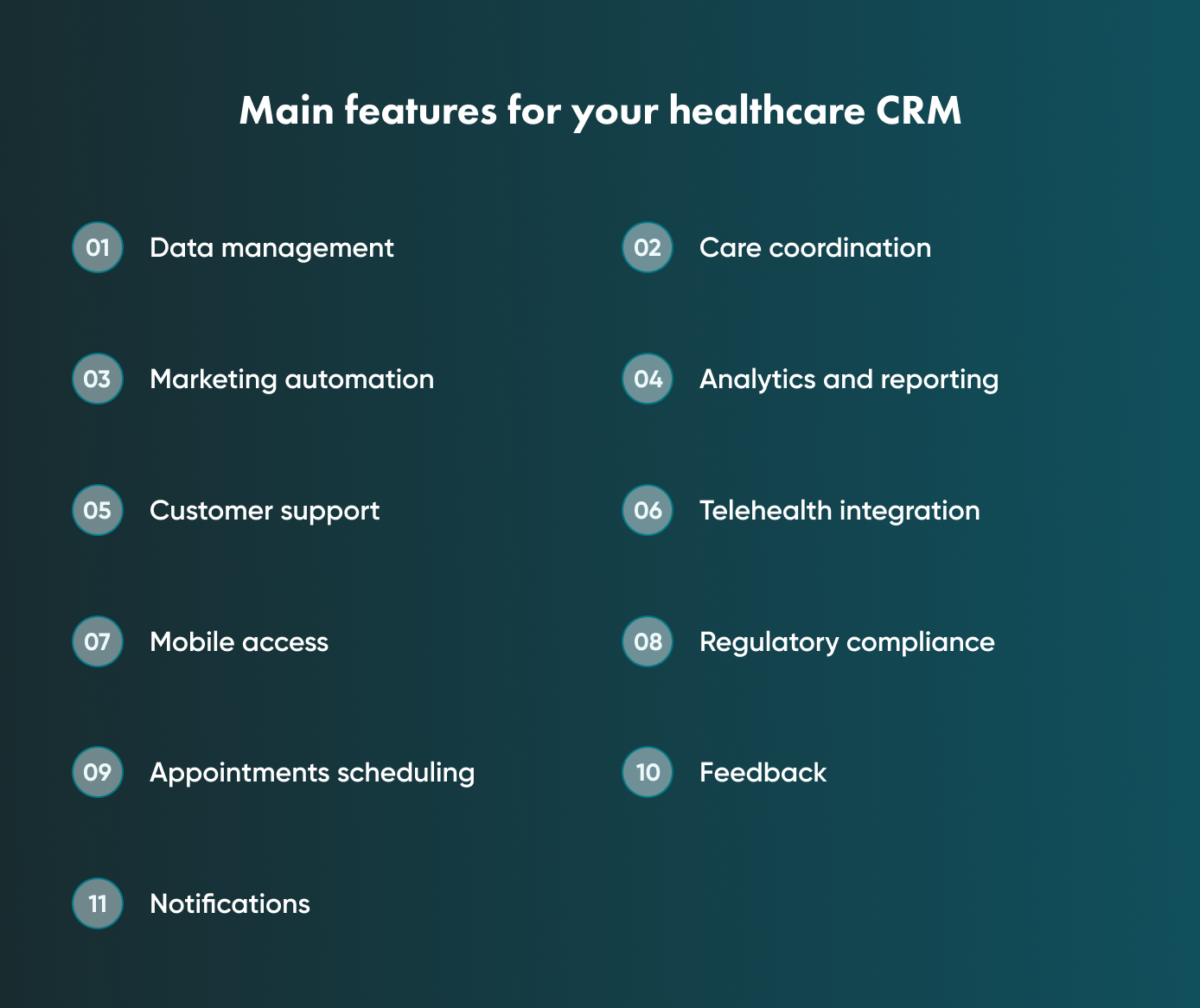
Core features to include in your medical CRM
Robust functionality makes your software reliable and practical.
Of course, your custom CRM software will be created considering its requirements and goals, but there is a list of must-have features to include in your future medical CRM software.
Data management
A healthcare CRM system should have a robust patient management feature that allows healthcare providers to manage patient information, appointments, treatments, and communication.
Care coordination
Your CRM software should have a care coordination feature that will help facilitate communication and information sharing and streamline workflows.
Marketing automation
A CRM system should offer marketing automation features like lead tracking, email campaigns, and social media integration to help healthcare institutions generate leads and grow their business.
Analytics and reporting
The software must provide robust analytics and reporting capabilities that allow healthcare providers to track patient behaviour, identify trends, and make data-driven decisions.
Customer support
Your CRM system should have a customer service feature that allows customer service managers to respond to patient inquiries, concerns, and feedback.
Telehealth integration
The software should be able to integrate with telehealth platforms to enable remote consultations and virtual care.
Mobile access
A healthcare CRM system should provide mobile access so that healthcare providers can access patient information, manage appointments, and communicate with patients on the go.
EHR integration
Healthcare CRM solutions should integrate with EHR systems to allow healthcare providers to access patient information and manage care more efficiently. For additional information, you can read our guide on EHR system development.
Regulatory compliance
Additionally, CRM systems should provide compliance management features that ensure healthcare organisations meet regulatory requirements and maintain patient privacy.
For example, if you create a CRM for the US, it must comply with HIPAA regulations. In contrast, a CRM which processes and stores data of EU residents must follow GDPR. We have an article on this which spells everything out.
Appointments scheduling
Doctors can view their appointment schedule at once and, if needed, correct it. This is possible because they have previously discussed this with their patients. Some CRMs even enable automated interaction with patients for customising the appointment time.
Feedback
This feature can be a precious tool for healthcare providers to gather insights from their patients and improve the quality of their care.
By allowing patients to provide feedback on their experiences, healthcare providers can identify areas for improvement and take corrective action to address issues.
Notifications
This feature can automatically send appointment reminders to patients via email or text message. It can help reduce the number of missed appointments and improve patient satisfaction.
Besides that, healthcare providers can receive notifications when a patient is referred to them from another provider, enabling them to quickly follow up with the patient and ensure that they receive the appropriate care.
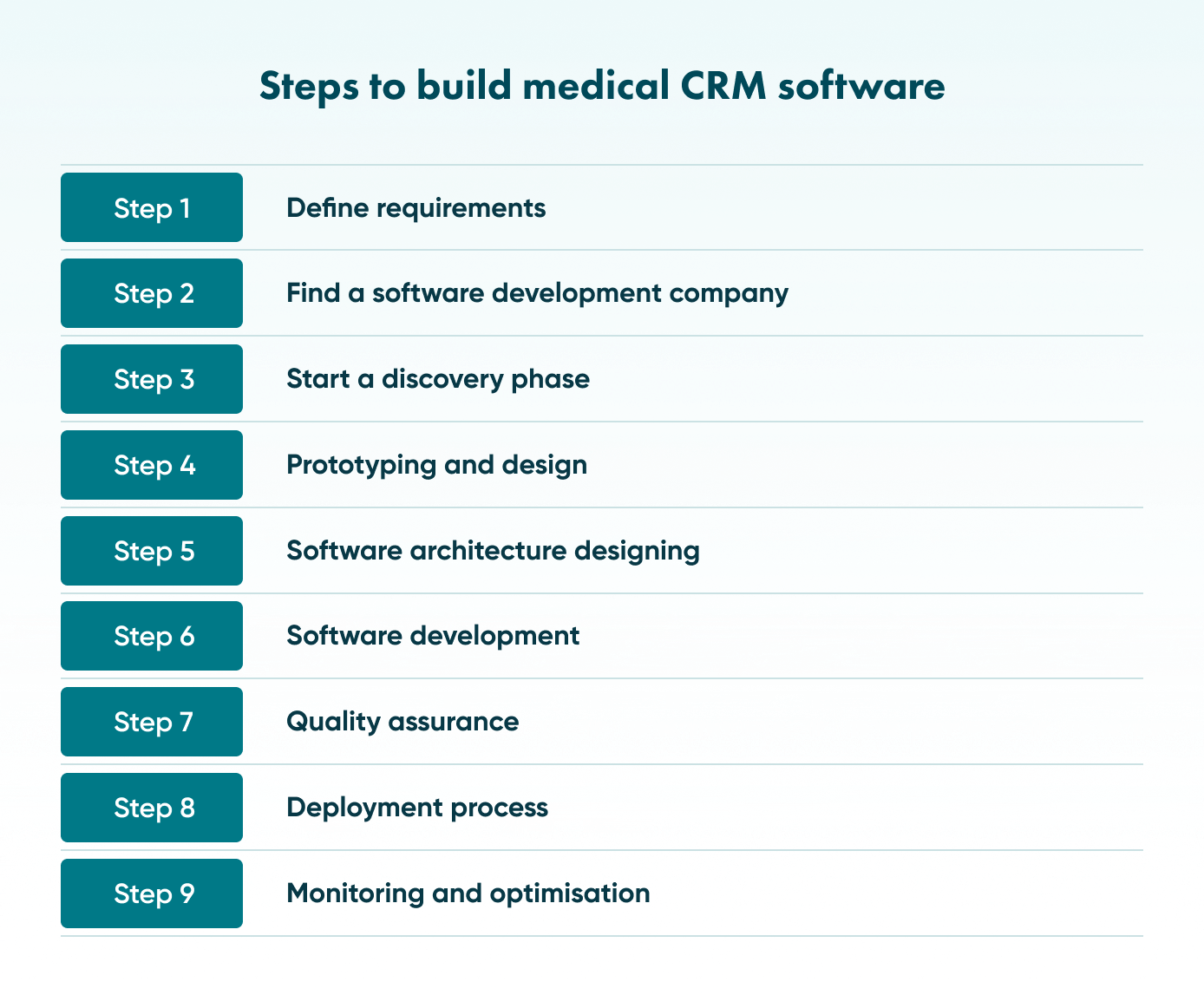
Steps to create the best CRM for healthcare
If you want your CRM system to be created wisely, considering all your requirements, follow the steps we provide below.
1. Define requirements
The first step in creating healthcare CRM software is to define the requirements. It involves identifying the needs of healthcare providers, patients, and other stakeholders and understanding how the software will address these needs.
Also, you need to provide the feature list that will be integrated into your CRM system.
2. Find a software development company
You won’t be able to build highly-functioning CRM healthcare software without the assistance of a skilled development team. You need to use websites like Clutch.co or GoodFirms to find the company you need according to your requirements.
We recommend not restricting the geographical limits – outsourcing companies in offshore regions can provide you with affordable rates and high-quality services.
3. Start a discovery phase
The discovery phase in software development is essential before the actual development process begins. It is a collaborative process where the development team, stakeholders, and clients work together to understand the problem or need the software intends to address, identify the project scope, and define the requirements.
During the discovery phase, the team typically conducts meetings, interviews, and workshops to gather information, discuss ideas, and establish goals. Also, the discovery phase helps manage risks and avoid unexpected mistakes. You can find out more about the discovery phase in our detailed article.
4. Prototyping and design
Prototyping and design are critical components of software development. These processes allow software developers to better understand the needs and expectations of their users.
By creating prototypes and designing interfaces, they can observe how users interact with the software and make changes based on their feedback.
Also, prototyping provides faster feedback from users, allowing the development team to make changes and improvements quickly. It helps avoid costly mistakes and ensures the final product meets the user's needs.
5. Software architecture designing
Once the requirements are defined, the next step is to design the architecture of the hospital CRM software. This involves determining the software modules, data models, and integrations with other systems, such as EHRs and telehealth platforms. The design should also consider the software's scalability, security, and performance.
6. Software development
With the architecture in place, the next step is to develop the best healthcare CRM software. The process includes coding the software modules, designing the user interface, and integrating the software with other systems. Finally, the software can be created using agile methodology for iterative development and testing.
7. Quality assurance
After the development process, the next step is to test and debug it.
At Go Wombat, this process may include conducting functional, performance, and security testing to ensure that the software meets defined requirements and is free of bugs. Again, a dedicated QA team should complete the testing and address any issues promptly.
However, once QA engineers test the CRM software, healthcare providers can also do it to check how the system works.
8. Deployment process
Next, the healthcare CRM software is ready for deployment. This implies installing the software on the servers, configuring the software settings, and training the end users on how to use it. The training should be tailored to the needs of the end users and should explain in detail the functionality nuances.
9. Monitoring and optimisation
You must recognise this step even when the software is deployed, configured, and fully utilised. You need to track key performance metrics such as system uptime, user adoption, and customer satisfaction, as well as identify areas for improvement.
Challenges of healthcare CRM system development
Any software development has its pitfalls, and CRM systems for healthcare are no exception. Here’s four main challenges to consider:
Scalability
As a healthcare organisation grows, so does its patient base, and the data needs to be managed. A CRM system needs to be scalable to accommodate this growth, with the ability to handle larger volumes of data and users.
Security
A CRM for a hospital needs to be secure to protect sensitive patient data from data breaches and cyberattacks. Therefore, developers must design the system with security in mind, with features such as encryption, access controls, and monitoring.
Integration with existing systems
Healthcare CRM software needs to integrate with existing systems, such as EHRs, telehealth platforms, and other healthcare software. It can be challenging, as different systems may use different data formats and protocols.
User adoption
CRM systems need to be user-friendly and intuitive to encourage user adoption. Developers need to consider the needs of different users, such as doctors, nurses, and administrative staff and then design the system accordingly.
Conclusion
The development process of hospital CRM software can be tricky, and making everything yourself is complicated.
Although different website and app builders allow everyone to create their software without coding skills, you won’t get the desired product since builders cannot provide the required functionality for the whole software.
That is why reading this article is pertinent to know all the nuances and steps to be taken. Go Wombat will do the rest — our task and goal are to make software you will be satisfied with.
So, let’s do it together. Contact Go Wombat and share your project details!
Unlock Success with Premium Software Development
Contact us


FAQs
What is CRM healthcare software?
CRM healthcare software is a tool healthcare providers use to manage their interactions with patients and their practice's administrative and operational aspects. The software is designed to help healthcare providers manage patient data, track patient interactions, schedule appointments, and automate various tasks related to patient care.
How is CRM used in healthcare?
CRM healthcare software manages patient data, such as demographics, medical history, medications, and test results. Also, it can schedule appointments, send appointment reminders, and manage patient waitlists. In addition, it helps communicate with patients via email, SMS, or other channels.
What CRMs do hospitals use?
Hospitals use various CRM software depending on their needs and preferences. Here are some examples of CRMs commonly used in hospitals:
- Salesforce Health Cloud. This is CRM software specifically designed for the healthcare industry. It allows hospitals to manage patient data, appointments, and communications in one central platform.
- Microsoft Dynamics CRM. This is a general-purpose CRM software that can be customised to meet the needs of healthcare providers. It includes features for managing patient data, appointment scheduling, and patient communication.
- Zoho CRM. A cloud-based CRM software that can be used by small to medium-sized hospitals. It includes features for managing patient data, appointment scheduling, and patient communication.
How can we help you ?





